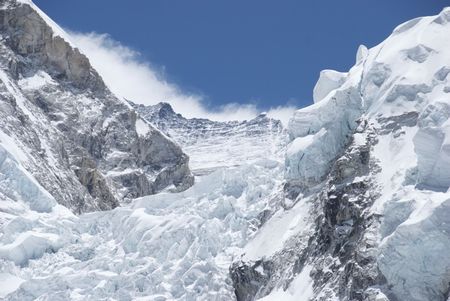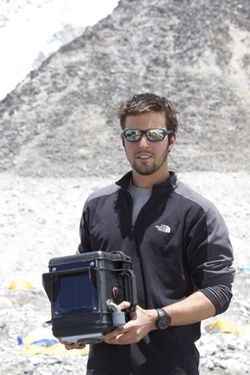
Most climbers get a little restless in Base Camp. There’s not a lot to do other than read the latest weather report, eat, sleep, sharpen crampons, take a Sherpa shower, and wait for a decent summit window. , on the other hand, has been photographing human limbs and other garbage that has been migrating down the Khumbu Icefall.
Richards, a climber and photographer sponsored by , isn’t here to summit Everest. Instead, he, along with , Passang Tenzing Sherpa (who has already reached the summit of Everest nine times), and Adam LeWinter, the engineer for James Balog’s , are climbing peaks surrounding the world’s highest mountain to install five time-lapse cameras that will document glacial movement and recession on the Khumbu Glacier.

“The EIS has cameras in Alaska, Montana, Iceland, and Greenland, and repeat photography in South America and the European Alps,” says LeWinter. “The Chacaltaya Glacier in Bolivia, which was the highest ski resort in the world, is already gone.”
The Everest team has already installed two cameras up close on a ridge of Khumbutse, just north of the Khumbu Icefall. Today they’ll install two more on the slopes of Pumori and, ultimately, will work their way down valley to install one on a glacier on the south side of Ama Dablam. Ultimately they’ll have four different angles from which to gather photographs.
Housed in beefy, retrofitted Pelican cases, the solar-powered Nikon D200 and D300s cameras that run on 12v batteries will remain in place for a year. Each camera, which operates on a timer system, will take a photo of the glacier every 15 minutes. Every six months Passang Tenzing or someone on the team will physically collect the images stored on the 32-gigabyte cards.
“We’re not only trying to show glacial movement and recession,” says Richards. “As the glaciers are melting, it allows cleanup to take place–not just garbage, but human limbs. What’s interesting is that if we can ID the watch on the arm I just photographed, we can find out where in the Icefall the climber was when he died and how far the limb has traveled, which makes a poignant case for global warming.”
As for the garbage? “It’s pretty incredible just how messy it is,” says Richards.
–Stephanie Pearson